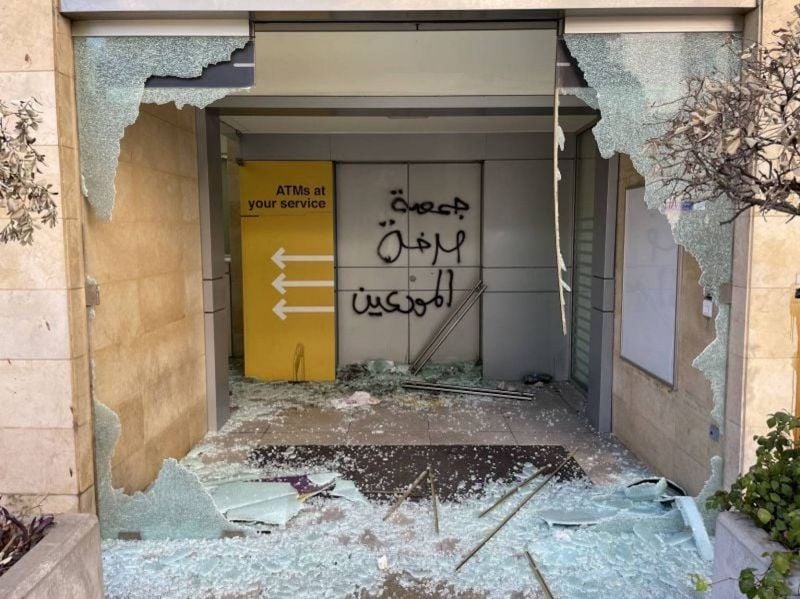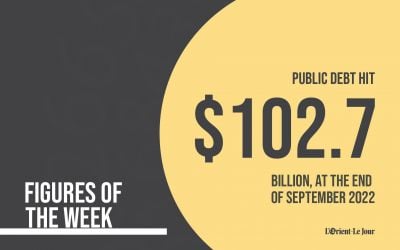
A group of protesters claiming to be angry depositors set fire to several bank branches in Beirut’s Badaro neighborhood, Thursday. (Credit: P.H.B.)
As of Friday, the Lebanese lira is trading above LL80,000 against the dollar, a drop from LL65,000 at the beginning of the week and LL42,500 on Jan. 1, 2023.
The free fall of the national currency has angered many depositors, who took to burning several bank branches Thursday.
The real shock, however, was the speed at which the lira lost value.
It took barely a month and a half for the lira to drop nearly LL40,000 against the dollar. In comparison, the lira depreciated by the same amount in the space of three years, between the summer of 2019 and the end of 2022.
In percentage terms, however, the most recent change is less impressive compared to other episodes.
The jump recorded this time is “only” 90 percent. Meanwhile, between the beginning of June and the beginning of July 2020, the depreciation stood at 145 percent, going from LL4,000 to LL9,800 against the dollar in the span of just one month.
These changes are nonetheless brutal for the daily life of Lebanese people, since this exchange rate reflects the national currency’s true value in a market that brings together legal and illegal brokers as well as individuals dealing directly with one other.
“It is a market that is not transparent, not regulated and under no one’s supervision,” Nassib Ghobril, director of the research department at Byblos Bank, told L’Orient-Le Jour.
Incidentally, all exchange platforms are in fact informal. The stakeholders involved in these platforms and the amounts exchanged remain unknown. What’s more, there are significant disparities between the rates applied in some areas compared to others, not to mention other irregularities.
The influence of Banque du Liban, which operates the Sayrafa platform with a much lower lira-to-dollar exchange rate, appears equally difficult to understand.
For all these reasons, it is therefore difficult to precisely identify the reasons for the exchange rate fluctuations from one period to another.
But it is possible to list some explanations.
“There are several factors that may come into play, but I think that the imbalance between the dollar demand and supply, and the increase in speculation are the main drivers of the rate’s fluctuations in recent times,” Ghobril said.
It is also important to consider the changes in the lira rate in relation to its starting value, which was officially pegged at LL1,507.5 to the dollar.
Variation and value
While the lira has collapsed by LL40,000 to the dollar since the beginning of the year, this quantitative jump is in fact only a marginal depreciation compared to what the national currency was worth before the crisis began.
For instance, when the rate stood at around LL42,000 to the dollar at the beginning of the year, the depreciation was at only 96.4 percent. And now at LL80,000, the ratio is 98.1 percent.
The same relativity applies to variations: a fluctuation of LL100 more or less than the old official rate translates into a depreciation of 6.6 percent.
The same LL100 fluctuation at LL42,000 to the dollar translates into a 0.24 percent depreciation. At the LL80,000-to-the-dollar rate, the same LL100 fluctuation only moves the rate by 0.16 percent.
It is therefore not strange that the exchange rate fluctuations are increasingly important as the lira sinks, especially if the market is mainly influenced by speculators whose main objective is to generate profits in dollars by betting on an increase in the lira value.
Keeping these parameters in mind, we can deduce that the fluctuations recorded in recent weeks are relatively less painful than those seen in 2020, for example.
Less Sayrafa
But the relativity of exchange rate fluctuation alone does not explain the recent downturn. Another cause could be related to the decline in the number of formal players involved in foreign exchange operations.
On the one hand, BDL and banks have gradually stopped converting dollars at the Sayrafa platform's subsidized rate (LL44,100 to the dollar on Feb. 15) on behalf of their private sector clients, which has limited the quantity of dollars injected into the market.
The exact exchanged volumes are not known, but it can be assumed that the decline was drastic, given the differences in those reported by BDL for Sayrafa-related transactions.
Between Dec. 27 and Jan. 5, when the conversion caps were temporarily lifted, an average of $233.4 million was traded daily for five days of actual processing.
These volumes fell back below $100 million by Jan. 10 and below $50 million for the past 10 days.
It should be noted BDL does not provide the breakdown of these figures, so it is complicated to draw a definitive conclusion.
This is especially true since the lira amounts in circulation have decreased overall since the beginning of the year, from LL80,171 trillion to LL75,379 trillion between the beginning of the year and Feb. 15, according to data from BDL.
Moreover, this amount remained stable over the last 15 days during which the lira-to-dollar exchange rate decreased by about LL20,000 to the dollar.
Sanctions, arrests and transfer companies
Since the beginning of the year, the Lebanese foreign exchange market has also been marked by other disturbances that may have been significant.
The US administration took a major licensed player, CTEX, out of the picture in late January when it sanctioned the company, its owner Hassan Moukalled, and members of his family for “facilitating the financial activities of Hezbollah.”
At the same time, as part of a campaign led by the Lebanese authorities, Lebanese intelligence services have arrested a number of foreign exchange agents, particularly in southern Lebanon and the Bekaa Valley, who are accused of speculating against the lira.
It is safe to say that this initiative seems to have mainly reduced the number of players selling dollars on the market.
For their part, OMT and BOB Finance, two money transfer companies that BDL authorized more than a year ago to exchange money, have stopped their transactions since January.
Economic conditions and demand
Finally, if the lira is still collapsing, it is first and foremost because it no longer inspires confidence, as the prospects for the country's recovery are almost non-existent.
The ruling class has still not elected a president or replaced its caretaker government, and little progress has been made on implementing the reforms requested by the International Monetary Fund last April.
In addition, the country has not yet begun the transition to a more productive economy and survives mainly on remittances from the diaspora.
To make matters worse, the banks have been on strike for the past 10 days following a decision against one bank by the Court of Cassation in favor of a depositor who demanded that all of their deposits be disbursed in “real dollars” and not in lira at a discount.
This last practice was imposed by the restrictions illegally put in place by the banking sector and which have still not been regulated.
For the time being, only bank ATMs are open to the general public, while the bank staff members handle requests from companies.
Ghobril finally pointed to the unknown impact of the Syrian variable on the market — a reference to the demand for dollars coming from stockbrokers located at the border and entering Syria, whose regime is sanctioned by the US and the European Union, and which is also experiencing a shortage of currency.
A week ago, Syrian authorities decided to set the official exchange rate for the Syrian pound at a level almost equal to that of the parallel market. The official Syrian rate currently stands at SP6,900 to the dollar, compared to the parallel market rate of SP7,400.
This article was originally published in French in L’Orient-Le Jour. Translation by Sahar Ghoussoub.


